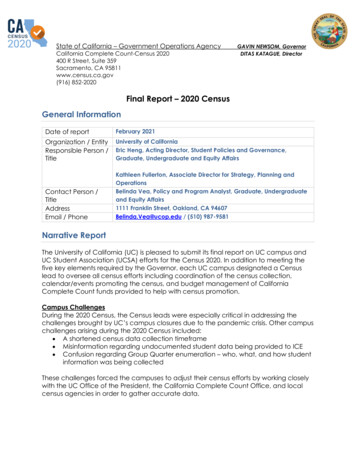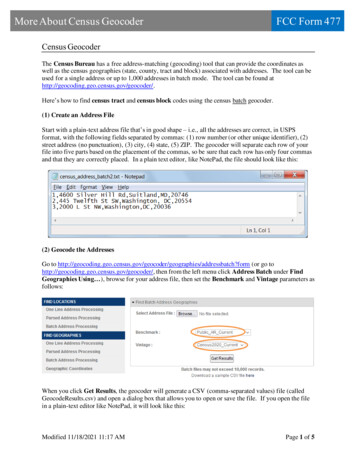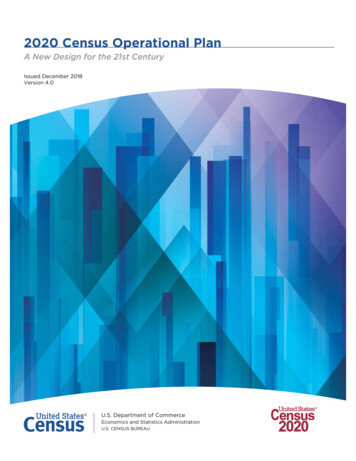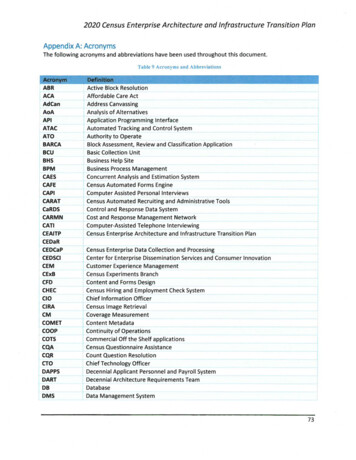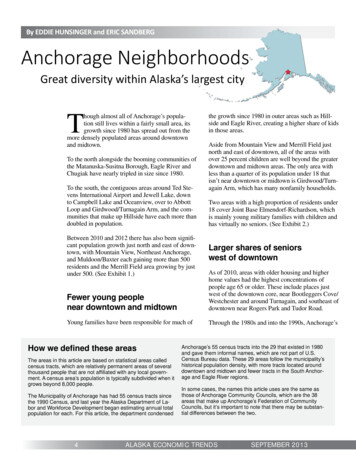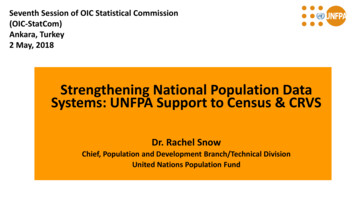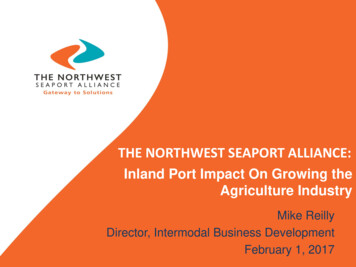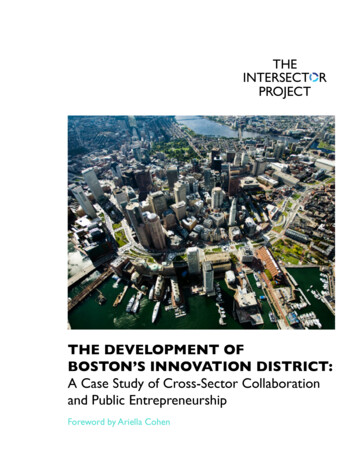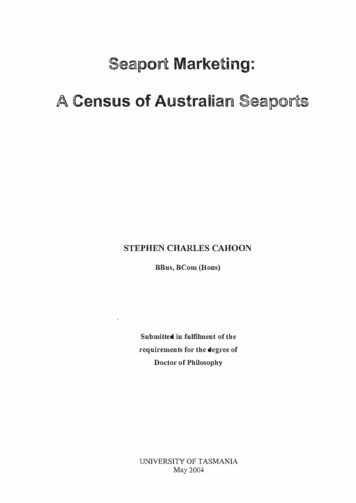
Transcription
Seaport Marketing:A Census of Australian Seapo rr1sSTEPHEN CHARLES CAHOONBBus, BCom (Hous)Submitted iu fulfilmeut of therequiremeuts for the degree ofDoctor of PhilosophyUNIVERSITYOF TASMANIAMay 2004
iiDECLARATION OF ORIGINALITYThis thesis contains no material which has been accepted for a degree or diploma by theUniversity or any other institution, except by way of background infonnation and dulyacknowledged in the thesis, and to the best of the candidate's knowledge and belief nomaterial previously publishedor written by anotheracknowledgement is made in the text of the thesis.Signedpersonexceptwheredue
STATEMENT OF AUTHORITY OF ACCESSThis thesis may be made available for loan and limited copying in accordance with theCopyrightAct 1968.Signed
1\"ABSTRACTIn recent times, the Australian seaport sector has witnessed a transformation inownership,management, and operations as a result of government reform anddevelopments in the broader maritime industry.This has created a hypercompetitiveenvironment, typical of the New Economy, in which seaports must now manage.Seaports are facing an erosion of their once monopolistic positions and declining levelsof captive trade as hinterlands continue to blur forcing seaports to compete for trade. Agrowing number of researchers have recommended the development of marketingstrategies as iveenvironment. However, a review of the extant literature on seaport marketing indicatesa paucity of conceptual and empirical research especially in the area of in-depthresearch focusing on the extent of marketing being conducted by seaport management.As the seaport sector in Australia represents a prIme example of the challengingenvironment of the New Economy, the objective of this thesis is to investigate whichmarketing activities and strategies may be appropriate for these seaports.This isaddressed by (i) examining the marketing activities and strategies currently beingpractised by Australian seaports; (ii), assessing whether they are based on servicesmarketing principles; and (iii) determining whether the current seaport marketingactivities and strategies are relevant for successfully marketing Australian seaports.To establish the extent of marketing within Australian seaports, a census of all54commercial seaports was conducted via in-depth telephone interviews with the30senior seaport managers responsible for marketing those seaports.interviews consisted ofThe telephone184 quantitative and qualitative items covering ten specificmarketing dimensions (market research and segmentation, seaport product, logistics,
vseaport pricing, marketing communication, seaport servicescape, seaport employees andcustomers,serviceprocesses,customerrelationship management,andcustomersatisfaction), as well as the competitive environment, marketing strategy, demographics,and a peer assessment section focusing on the marketing efforts of other Australianseaports.An analysis of the census data reveals a diverse range of seaports operating In acompetitive environment, and which, although similar in the range of marketing effortsundertaken, vary considerably in their depth and strategic focus. It was found that overthe past five years in particular, more seaports are relying on services marketing basedactivities as a means of attracting additional trade and retaining current customers.Inaddition, a greater emphasis is being placed on being customer-focused, which isrecognised as being a necessary precondition for seaport success. It was also found thatthe primary marketing activities relevant to all seaports are promotion, communityconsultation, trade development, and customer relationship management.The majorchallenge however, is in managing them in an integrated manner with other servicesmarketing based activities to provide a strategic approach for seaport marketing.It issuggested that strategic tools such as the expanded marketing mix are relevant as afoundation on which to develop marketing for seaports.expanded marketingmixwillassistseaportImportantly, the use of themanagersconsiderthemarketingimperatives of each element, whereas currently, many are considered primarily fromeither a physical product or operational paradigm. It is further suggested that regardlessof seaport size, marketing has become a necessary seaport management function thatpresents many opportunities for both trade and financial growth.
vseaport pricing, marketing communication, seaport servicescape, seaport employees andcustomers, dcustomersatisfaction), as well as the competitive environment, marketing strategy, demographics,and a peer assessment section focusing on the marketing efforts of other Australianseaports.An analysis of the census data reveals a diverse range of seaports operating In acompetitive environment, and which, although similar in the range of marketing effortsundertaken, vary considerably in their depth and strategic focus. It was found that overthe past five years in particular, more seaports are relying on services marketing basedactivities as a means of attracting additional trade and retaining current customers.Inaddition, a greater emphasis is being placed on being customer-focused, which isrecognised as being a necessary precondition for seaport success. It was also found thatthe primary marketing activities relevant to all seaports are promotion, communityconsultation, trade development, and customer relationship management.The majorchallenge however, is in managing them in an integrated manner with other servicesmarketing based activities to provide a strategic approach for seaport marketing.It issuggested that strategic tools such as the expanded marketing mix are relevant as afoundation on which to develop marketing for seaports.expanded marketingmixwillassist seaportImportantly, the use of themanagersconsiderthemarketingimperatives of each element, whereas currently, many are considered primarily fromeither a physical product or operational paradigm. It is further suggested that regardlessof seaport size, marketing has become a necessary seaport management function thatpresents many opportunities for both trade and financial growth.
VIACKNOWLEDGEMENTSEveryone throughout his or her life has at least one Everest to conquer - writing thisthesis has been one of mine. What an incredible experience, a journey of contrastinghighs and lows and of self-development.During the journey there were a number ofpeople who showed interest, made the journey a much more enjoyable and even greaterlearning experience, and of course there were those who offered their unending supportand understanding. To all of you, thank you and I hope you will join me in celebratingthis achievement.There are however, some people who deserve special mention fortheir assistance in completing this thesis:Dr Rob Hecker, well Rob we got there, thank you for your insights and usefulsuggestions, you are responsible for guiding me to the completion of this thesis, and forthat you have my gratitude.Dr Jacqueline Flint, who began as my first supervisor, started me on my doctoralexperience, became a mentor and a friend. Jacqueline, thank you, you have played sucha big role in how I now think and act as an academic.Dr Devinder Grewal and Dr Barrie Lewarn, for their latitude in providing time andresources whilst atAMCto conduct this research. Additional thanks Devinder for ourmany discussions about seaports and for working through an early draft of the first fewchapters.Greg Smith, for assistance with the seaport population for the census, Greg, because ofyou this thesis achieved a100 per cent response rate,many thanks.
VllFriends and AMC colleagues, for your interest in 'that book you're writing'. One friendin particular deserves special mention, Mr Geoffrey Howard, for helping in a wholerange of ways that enabled me to concentrate more on my research, thanks Geoff.To my parents Joan and Charlie Cahoon and brothers Colin and Gary and his wifeVictoria, and the Harris family, we joked when I began the doctoral journey that itwouldn't happen overnight, and we were right, but it did finally happen.It has takenlonger than we all expected, but throughout all that time, you believed in me, showedinterest and concern, and if it had not have been for your support, the journey wouldhave been more difficult. Also a special thanks to you Dad for doing all those jobs thatI never seemed to have time for, I really appreciated your time and ready assistance.To my wife Jenny and three exceptional children, Kristina, Stevie and Shannon, wordscan not express my appreciation and love,Iam so much looking forward to spendingmore time with you. Thank you for understanding how important the PhD was to me.There are two very special women I would like to dedicate this doctoral thesis to, mywife Jenny, and my mother Joan Cahoon.Mum, your belief in me is incredible, youwere always there caring and listening, I am so fortunate to have a mother like you,your role in the completion of the PhD is greater than you realise.Jenny, you havelived this thesis with me, you listened intently, provided the right advice, and offeredme your unending support and love enabling me to pursue my dream.I can ever repay all that you have done, butAsI now standI am unsure howI am sure you will think of something.at the top of my Everest, I realise how great the view is, [ also see thatthe stars are much closer, some within reach, many more things now seem possible.
VIllGLOSSARYAAPMAAustralian Association of Ports and Marine AuthoritiesACTAustralian Capital TerritoryAMCAustralian Maritime CollegeCEOChief executive officerCPVCost, performance, valueCRMCustomer relationship managementEDIElectronic data interchangeGRTGross registered tonnesGSTGoods and services taxHRMHuman resource managementMUAMaritime Union of AustraliaNSWNew South WalesNTNorthern TerritoryPRQlPrimary research question oneQLDQueenslandSASouth AustraliaSDStandard deviationSRQlSubsidiary research question oneSRQ2Subsidiary research question twoTASTasmaniaTEUTwenty equivalent unitsUKUnited KingdomUNCTADUnited Nations Conference on Trade and DevelopmentUSUnited States of AmericaVICVictoriaWAWestern AustraliaxArithmetic mean
IXTABLE OF CONTENTSDEClARATION OF ORIGINALITYiiSTATEMENT OF AUTHORITY OF ABLE OF CONTENTSLIST OF TABLESCHAPTER ONE: INTRODUCTIONixxvi11.1Introduction21.2Refocusing of seaport research61.3Purpose of the research1.3.11.4Proposed contribution of the researchThesis structureCHAPTER TWO: SEAPORTS AS ECONOMIC ENABLERS101213162.1Introduction172.2Seaports as a link in the transportation chain172.3Characteristics of seaports212.3.1Seaport objectives222.3.2Activities of seaports232.3.3Seaport ownership and administration252.3.4Seaport management282.3.5Seaport operations312.42.5The economic contribution of seaports332.4.1Contribution to the international economy352.4.2Contribution to the Australian economy36Summary39
xCHAPTER THREE: SEAPORTS IN THE NEW ECONOMY413.1Introduction423.2Seaports in the New Economy423.2.1The changing macroenvironment of seaports3.2. 1 . 1Factors leading to increased competition443.2.1.2Government seaport reform483.2.2 Seaports and increasing competitive pressures3.451Choice of a seaport53Overcoming competitive pressures543.2.33.3433.3.1Value adding553.3.2Co-opetition563.3.3Technology and competing on price573.3.4Emerging relevance of seaport marketing59SummaryCHAPTER FOUR: THE EMERGENCE OF SEAPORT MARKETING63654.1Introduction664.2Marketing as a total business concept664.34.2.1The marketing-oriented organisation694.2.2The market-oriented organisation71Development of seaport marketing744.3.1Market-oriented seaports774.3.2Role of the marketing department794.4Review of research on seaport marketing834.5Marketing for service businesses894.6Summary94CHAPTER FIVE: SERVICES MARKETING: A STRATEGIC TOOL FORSEAPORTS?955 .1Introduction965.2Marketing strategies965.2.197The expanded marketing mix
Xl5.3Services marketing strategies5.3.1Market research and segmentation1005.3.2Service product strategies for service businesses1015.3.3Distribution strategies for service businesses1035.3.4Pricing strategies for service businesses1055.3.5Marketing communication strategies for service businesses1095.3.5.15.499Word-of-mouth communication strategies1115.3.6Physical evidence strategies for service businesses1 135.3.7Employee and customer strategies for service businesses1 175.3.7.1Employee-focused strategies1 185.3.7.2Customer-focused strategies1245.3.8Service design and delivery strategies for service businesses1265.3.9CRM strategies for service businesses1285.3.9.1Customer satisfaction1285.3.9.2Relationship marketing1315.3.9.3Customer retention and service recovery1325.3.9.4Complaint management135Summary136CHAPTER SIX: SEAPORT MARKETING1386.1Introduction1396.2Seaport marketing activities and strategies1396.2.1Strategic seaport marketing1406.2.2Seaport marketing activities1446.2.2.1Market research1456.2.2.2The seaport product1486.2.2.3Distribution1526.2.2.4Pricing of seaport services1536.2.2.5Seaport promotion activities1626.3Seaports and services marketing1 686.4Summary170CHAPTER SEVEN: RESEARCH DESIGN AND METHODOLOGY7.1Introduction172173
Xli7.27.2. 17.2.27.3173Research designA census of Australian seaports7.2. 1 . 1Generation of the population1747.2.1.2The point of contact in the seaport180Data collectionSecondary data collection1827.2.2.2Primary data collection183Instrument developmentQuestion types and measurement scales7.3 .1.17.3.27.47.57.67.71827.2.2.1Telephone intelView methodology7.3.1174Instrument design and layout1871881921947.3.2.1Question order1997.3.2.2Question wording2007.3.2.3Layout of the census instrument201202Pretesting7.4.1Developmental pretest2037.4.2Polishing pretest205Procedure for administering the census2067.5. 1Advance letter2067.5.2Confirmatory telephone intelView2117.5.3Conducting the telephone intelView213Error control process2147.6.1Nonresponse error2147.6.2Measurement error2177.6.2.1Reducing errors due to the format of the instrument2177.6.2.2Reducing errors due to the delivery of the instrument218SummaryCHAPTER EIGHT: SEAPORT AND RESPONDENT PROFILES2202218.1Introduction2228.2Census response rate2228.3Seaport profiles2268.3.1Seaport location and activity226
Xlll8.48.58.68.3.2Seaport ownership, management and operations2298.3.3Seaport trade and financial data2338.3.4Summary of the profile of Australian seaports236Respondent profiles2378.4.1Respondents' job positions2378.4.2Tenure at the seaport2408.4.3Educational background2418.4.4Summary of the profile of seaport managers242The emergence of marketing2428.5.1The impetus for marketing2448.5.2Marketing departments in seaports248Summary255CHAPTER NINE: MARKETING ACTIVITIES OF AUSTRALIANSEAPORTS2579.1Introduction2589.2Seaport marketing activities2589.2.19.3Market research and segmentation2609.2.2 The seaport product2689.2.3Logistics in seaports2739.2.4Seaport pricing2759.2.5Seaport marketing communication2839.2.6Seaport servicescapes2979.2.7Seaport employees and customers3019.2.8Seaport service processes3049.2.9CRM in seaports3069.2.9.1310Customer satisfactionSummary312CHAPTER TEN: STRATEGIC MARKETING BY AUSTRALIANSEAPORTS31310.1 Introduction31410.2 Seaport marketing strategies314
XIV10.2.1Seaport market orientation31810.3 Assessment of SRQl32510.4 Assessment of SRQ232810.5 Assessment of PRQ 133410.5.1Market research and segmentation strategies for Australianseaports33510.5.2Seaport product strategies for Australian seaports33610.5.3Logistical strategies for Australian seaports33810.5.4Seaport pricing strategies for Australian seaports33810.5.5Marketing communication strategies for Australian seaports34010.5.6Servicescape strategies for Australian seaports34210.5.7Employee and customer strategies for Australian seaports34410.5.8Service process strategies for Australian seaports34510.5.9CRM strategies for Australian seaports34510.5.10 Seaport marketing in the future10.6 SummaryCHAPTER ELEVEN: CONCLUSIONS3463473491 1. 1 Introduction35011.2 Purpose and value of the research3501 1.3 Summary of results3521 1.4 Limitations of the study35611 .5 Directions for future research358REFERENCES361APPENDIX A: COMPARISON OF SEAPORT LISTS394APPENDIX B: CENSUS INSTRUMENT409APPENDIX C: MARKET ORIENTATION QUESTIONS440APPENDIX D: RESPONSE CARDS A TO C442APPENDIX E: ADVANCE LETTER446APPENDIX F: CONFIRMATORY TELEPHONE INTERVIEW448
xvAPPENDIX G: EXPLANATORY PRETEST LETrER451APPENDIXH: DATA ANALYSIS455\iI!II!rlJTAS.'.,----- .
XVlLIST OF TABLESTable 2.1 :Definitions of a seaport19Table 2.2:Categorisation ofseaport services24Table 2.3:Contribution of seaports to the economy34Table 2.4: Australia's total international trade by transport mode37Table 6. 1:Categorisation 0 f seaport services150Table 7.1 : Dimensions used to determine marketing activities and strategies189Table 7.2: Business philosophies of seaports192Table 7 .3:Interview schedule questions by typeTable 7.4: Anticipated fallback questions193213Table 8. 1 :Seaports categorised b y location and type227Table 8.2:Seaport management and operations230Table 8.3: Titles of commercial Australian seaports (2003)231Table 8.4: Titles of commercial Australian seaports (1993)232Table 8.5:234Seaport trade and financial dataTable 8.6: Australian seaports categorised by trade throughput tonnes,gross revenue and total assets235Table 8.7:Respondents' characteristics237Table 8.8:Respondents' job titles238Table 8.9:Reasons for beginning marketing of the seaport245Table 8.10: Use of marketing in Australian seaports247Table 8.11: Why a marketing department is required in a seaport253Table 9.1:Marketing activities 0 f Australian seaports258Table 9.2:Selected market research questions260Table 9.3:Services provided by private sector or seaport270Table 9.4:Reasons customers use the seaport272Table 9.5:Determining seaport charges280Table 9.6:Promotional activities of Australian seaports283Table 9.7:Examples of seaport slogans287Table 9.8:Customers and seaport staff302Table 10. 1 : Dimensions of seaport market orientation3 19Table 10.2: Career background of the CEO323
of captive trade as hinterlands continue to blur forcing seaports to compete for trade. A growing number of researchers have recommended the development of marketing strategies as a means to offset the challenges created by a hypercompetitive environment. However, a review of the extant literature on seaport marketing indicates

